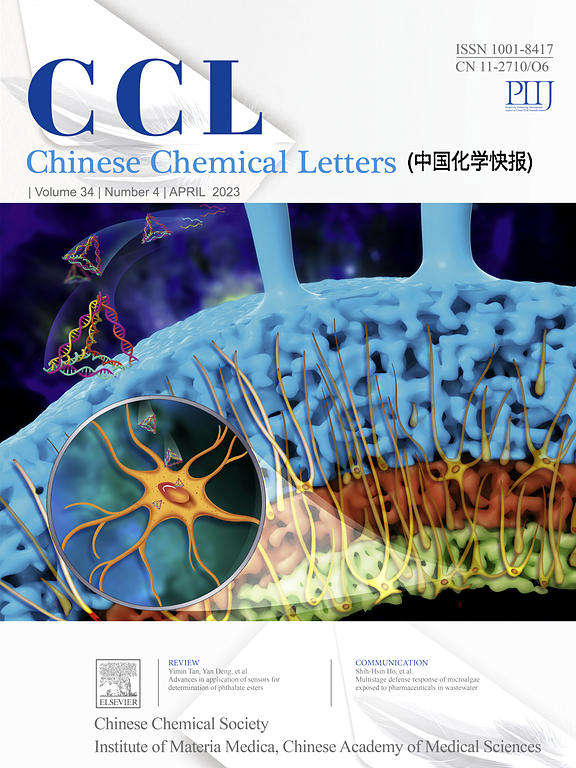无铅钙钛矿Cs3Bi2Br9/FeS2中空核壳z型异质结优化光热-光催化制氢
IF 8.9
1区 化学
Q1 CHEMISTRY, MULTIDISCIPLINARY
引用次数: 0
摘要
光热催化是一种很有前途的技术,主要利用太阳能在产生热能的同时产生光生e-/h+对。然而,由于载流子分离效率低和对近红外(NIR)光响应不足,导致其光催化效率不理想,阻碍了其应用潜力。本研究同时验证了在无铅钙钛矿Cs3Bi2Br9/FeS2 (CBB/FS)异质结构上光热催化析氢反应的显著增强,其中CBB/FS z型异质结表现出较强的稳定性和优异的光热催化活性。在模拟太阳辐射(AM 1.5G)下,优化后的CBB/FS-5的光催化析氢速率为31.5 mmol g-1 h-1,分别是FS和CBB的112.6倍和77.1倍,在420 nm处的表观量子产率为29.5 %。这种显著改善的光催化析氢主要归因于Z-scheme电荷转移和光热辅助协同增强的光催化制氢,并通过光电化学表征、原位XPS、EPR光谱和DFT计算提出了增强的光催化析氢的潜在机制。这项工作为高效光热催化剂的设计提供了新的见解,为解决能源和环境挑战提供了可持续和高效的解决方案。本文章由计算机程序翻译,如有差异,请以英文原文为准。

Lead-free perovskite Cs3Bi2Br9/FeS2 hollow core-shell Z-scheme heterojunctions toward optimized photothermal-photocatalytic H2 production
Photothermal catalysis is a promising technology primarily utilized the solar energy to produce photogenerated e-/h+ pairs together with the production of heat energy. However, the inefficient separation of charge carriers and inadequate response to near-infrared (NIR) light usually leads to the unsatisfactory photocatalytic efficiency, hindering their application potentials. In this work, a significantly enhanced photothermal catalytic hydrogen evolution reaction over the lead-free perovskite Cs3Bi2Br9/FeS2 (CBB/FS) heterostructure is simultaneously verified, where the CBB/FS Z-scheme heterojunctions display the strong stability and superb photothermal catalytic activity. Under the simulated solar irradiation (AM 1.5G), the optimized CBB/FS-5 achieves a photocatalytic hydrogen evolution rate of 31.5 mmol g-1 h-1, which is 112.6 and 77.1 times higher than that of FS and CBB, respectively, together with an apparent quantum yield of 29.5 % at 420 nm. This significantly improved photocatalytic H2 evolution can be mainly attributed to the Z-scheme charge transfer and photothermal-assisted synergistically enhanced photocatalytic H2 production, and the potential mechanism of the enhanced photocatalytic H2 evolution is also proposed by photoelectrochemical characterizations, in situ XPS, EPR spectra, and the DFT calculations. This work provides new insights to the design of high-efficient photothermal catalysts, leading to the sustainable and efficient solutions towards the energy and environmental challenges.
求助全文
通过发布文献求助,成功后即可免费获取论文全文。
去求助
来源期刊

Chinese Chemical Letters
化学-化学综合
CiteScore
14.10
自引率
15.40%
发文量
8969
审稿时长
1.6 months
期刊介绍:
Chinese Chemical Letters (CCL) (ISSN 1001-8417) was founded in July 1990. The journal publishes preliminary accounts in the whole field of chemistry, including inorganic chemistry, organic chemistry, analytical chemistry, physical chemistry, polymer chemistry, applied chemistry, etc.Chinese Chemical Letters does not accept articles previously published or scheduled to be published. To verify originality, your article may be checked by the originality detection service CrossCheck.
 求助内容:
求助内容: 应助结果提醒方式:
应助结果提醒方式:


